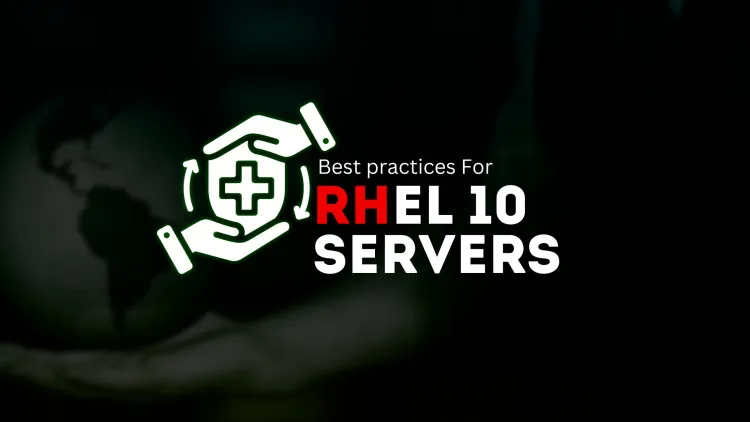Best Practices for Managing and Maintaining RHEL 10 Servers
Red Hat Enterprise Linux (RHEL) 10 offers robust features for managing and maintaining servers in modern IT environments. Best practices include regular updates, strong security measures, optimized resource utilization, regular backups, and automation of repetitive tasks. Monitoring systems with tools like Red Hat Insights and ensuring compliance with standards further enhance reliability. With tools like Ansible, system roles, and Cockpit, RHEL 10 simplifies server management, making it a powerful choice for enterprise workloads.

Red Hat Enterprise Linux (RHEL) 10 continues to set the benchmark for enterprise-grade Linux distributions. Its reliability, robust security features, and support for modern workloads make it an ideal choice for servers in various environments. However, to get the most out of your RHEL 10 servers, proper management and maintenance practices are essential.
In this blog, we will explore the best practices for managing and maintaining RHEL 10 servers to ensure optimal performance, security, and uptime.
Why Effective Server Management Matters
Efficient server management involves monitoring, maintaining, and optimizing your system to ensure it runs smoothly. Proper server maintenance helps:
- Maximize performance and resource utilization.
- Ensure data security and compliance with industry standards.
- Minimize downtime and reduce operational costs.
- Prepare your systems for scalability and future growth.
RHEL 10 introduces tools and features that make server management more efficient, but applying the right practices is key to leveraging these advantages.
Best Practices for Managing and Maintaining RHEL 10 Servers
1. Keep Your System Updated
Regularly updating your server is one of the simplest yet most effective ways to maintain security and functionality.
- Use Red Hat Subscription Manager (RHSM): Ensure your server is subscribed to receive the latest updates.
- Schedule Updates: Set up a routine for applying patches, especially for critical vulnerabilities.
- Automation Tools: Use tools like Ansible or dnf-automatic to automate updates.
- Kernel Updates: Keep your kernel updated to benefit from performance and security improvements introduced in RHEL 10.
2. Implement Strong Security Measures
RHEL 10 provides advanced security features, but they need to be properly configured and maintained:
- Enable SELinux: Security-Enhanced Linux (SELinux) enforces strict access controls. Keep it enabled and configure policies as needed.
- Firewall Management: Use firewalld to manage and monitor incoming and outgoing traffic.
- User Management: Limit root access and implement strong password policies. Use sudo for administrative tasks.
- Regular Vulnerability Scans: Use tools like OpenSCAP to identify and remediate vulnerabilities.
3. Optimize Resource Utilization
Efficient use of resources is crucial for performance and cost management.
- Monitor Performance: Use tools like top, htop, and sar to track CPU, memory, and disk usage.
- Tune System Parameters: Utilize tuned profiles for specific workloads, such as virtual machines or databases.
- Manage Storage: Use LVM (Logical Volume Manager) for flexible storage management and snapshot support.
- Container Management: Optimize containers with tools like Podman and manage resources effectively in containerized environments.
4. Backup and Disaster Recovery
Maintaining regular backups ensures you can recover data in case of hardware failure, cyberattacks, or other disasters.
- Automated Backups: Use tools like rsync, tar, or cloud-based solutions for regular backups.
- Test Backups: Periodically test your backups to ensure data integrity.
- Disaster Recovery Plan: Document and test a recovery plan to minimize downtime in case of failure.
5. Monitor Your Servers
Proactive monitoring helps identify potential issues before they become critical.
- System Monitoring Tools: Use Red Hat Insights, Nagios, or Zabbix for real-time system monitoring.
- Log Management: Analyze system logs using tools like journalctl and logrotate.
- Resource Alerts: Set up alerts for resource thresholds to avoid unexpected downtime.
6. Use Automation for Repetitive Tasks
Automation reduces human error and increases efficiency.
- Ansible Playbooks: Automate tasks such as patching, provisioning, and configuration management.
- System Roles: Leverage predefined RHEL system roles for common tasks like network configuration or security hardening.
7. Ensure Compliance with Standards
Adhering to compliance standards is critical, especially for industries with stringent regulations.
- CIS Benchmarks: Use SCAP Security Guide to ensure compliance with Center for Internet Security benchmarks.
- Audit Logs: Enable auditing with auditd to track system activity and meet compliance requirements.
- Encryption: Encrypt sensitive data using tools like LUKS for disks and GPG for files.
8. Plan for Scalability
RHEL 10 servers should be configured to handle future growth.
- Cloud Integration: Use Red Hat Hybrid Cloud Console to manage resources across on-premises and cloud environments.
- Container Orchestration: Integrate with Red Hat OpenShift for scalable application deployment.
- Storage Management: Plan storage growth with flexible solutions like GlusterFS or Ceph.
How RHEL 10 Tools Simplify Server Management
RHEL 10 comes with built-in tools that make server management more straightforward:
| Tool | Purpose | Use Case |
|---|---|---|
| Red Hat Insights | Predictive analytics | Identify and fix issues proactively. |
| Web Console (Cockpit) | Web-based management | Monitor and manage servers via a GUI. |
| Ansible Automation | Automation for IT tasks | Automate configuration and updates. |
| System Roles | Predefined roles for common tasks | Streamline configuration management. |
Conclusion
Managing and maintaining RHEL 10 servers requires a proactive approach that combines regular updates, strong security, resource optimization, and automation. By leveraging the tools and features RHEL 10 offers, such as Red Hat Insights and Ansible, IT administrators can ensure their servers remain secure, efficient, and prepared for future growth.
With these best practices in place, RHEL 10 servers can continue to provide the robust, reliable foundation businesses need to support their operations.
FAQs
-
Why is regular updating important for RHEL 10 servers?
Regular updates ensure your servers have the latest security patches, bug fixes, and performance enhancements. -
What tools can I use for automating server management in RHEL 10?
Tools like Ansible, dnf-automatic, and system roles help automate repetitive tasks and configuration management. -
How does RHEL 10 enhance server security?
RHEL 10 includes advanced security features like SELinux, firewalld, encryption, and compliance tools like OpenSCAP for vulnerability assessments. -
What are the key monitoring tools available in RHEL 10?
Monitoring tools include Red Hat Insights, Cockpit, Nagios, Zabbix, and journalctl for log analysis. -
How can I optimize resource utilization on RHEL 10 servers?
Use tuned profiles, logical volume management (LVM), and performance monitoring tools like htop and sar. -
What backup tools are recommended for RHEL 10 servers?
Use tools like rsync, tar, or cloud-based solutions to automate backups and ensure data recovery in case of failure. -
What is the role of system roles in RHEL 10?
System roles are predefined configurations for tasks like network setup, security hardening, and storage management, streamlining administration. -
How does RHEL 10 support scalability for future growth?
RHEL 10 integrates with cloud platforms, supports container orchestration with OpenShift, and offers flexible storage management options. -
What is Red Hat Insights, and why is it important?
Red Hat Insights is a predictive analytics tool that identifies and resolves potential issues before they impact server performance. -
Can RHEL 10 servers be managed through a web interface?
Yes, the Web Console (Cockpit) provides a user-friendly GUI for monitoring and managing servers, making administration more accessible.












![Top 10 Ethical Hackers in the World [2025]](https://www.webasha.com/blog/uploads/images/202408/image_100x75_66c2f983c207b.webp)

![[2025] Top 100+ VAPT Interview Questions and Answers](https://www.webasha.com/blog/uploads/images/image_100x75_6512b1e4b64f7.jpg)









